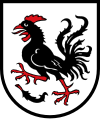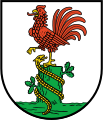Rooster (heraldic animal)
The heraldic animal rooster is usually shown ready to fight as a coat of arms.
It is not very stylized. The line of sight is to the right (heraldic) and one foot is raised. The tail has only a few feathers, but the crest is always a special feature of the coloring ( tinging ). The rooster with outspread wings is a special form. It is then a rooster ready to fly , sometimes emblazoned as a fighting rooster . A rooster that clearly holds up a claw is called arguing or ready to argue . The reinforcement (comb, rag, claws or foot with spur) is used by different colors to make the rooster look more beautiful.
In many coats of arms the rooster is in the castle gate , often on a mountain of three . Example coats of arms are Suhl and Frankfurt (Oder) .

The head can be put on a helmet. This then becomes a masked cock. Only the head can appear in the coat of arms. In exchange of the cock's head, a male head with a pointed hat ( Jewish hat ) is also chosen in the coat of arms, as in the coat of arms of Böhmisch Trübau . This extremely rare figure is a mythical creature and is known as a harpy . There are also roosters with fish tails ( sea cock , en. Cock with fish-tail , fr. Coq mariné ), z. B. in the civil coat of arms of Georg Aigl from Würzburg (1579) and roosters with goat heads, both chimeras .
Between 1789 and 1804 the rooster was a French heraldic animal and symbolized the freedoms that had been won. In the coat of arms of Versailles it is double-headed (double cock), an unusual shape. Even the logo of the EPP shows a tap.
If the description of the coat of arms speaks of a Calecutian or Calcutian rooster, the rare heraldic animal turkey is meant. The term refers to a former East Indian sub-empire. Siebmacher names the coat of arms of the Hünerwadel in Bern with a turkey in his book of arms.
Examples
Coat of arms of Frankfurt (Oder)
Coat of arms of Gerach in Obfr.
Coat of arms of Golzow
Talking in Haan , with a quarreling black cock ( Bergisches Kräher ) and a torn pen
Hahnheim coat of arms , speaking as in
Engenhahn or
Hahndorf , with weather vane
Weathercock in Albertslund Kommune
Letschin coat of arms
Coat of arms of Thalmassing
Black grouse in Twist (Emsland)
Coat of arms of Bohemian Trübau (Czech: Česká Třebová) with hybrid characters
Rooster in Kistarcsa (Hungary)
Hahn in Koppingen (Switzerland)
Rooster in Laitila (Finland)
Rooster in Oława (Poland)
Three heads in the coat of arms of Jesus College (Cambridge)
Coat of arms of the Counts of Hahn from Mecklenburg
Coat of arms of the von Spee
Coat of arms of Count Straka of Nedabylic
Double-headed rooster in natural colors in the Versailles coat of arms
Believe
In popular belief , the rooster is the symbol of fighting spirit and readiness to fight, as well as vigilance and sunrise . In Assyrian mythology , the rooster was a symbol of the fire god Nusku and the sun god Shamash . In Greek mythology he was sacred to Pallas Athene , Ares , Hermes , Apollon , Aesculapius , Demeter and Persephone . The Romans revered him as a symbol for the house guards. In Norse mythology z. B. two roosters the heroes in Odins and the powers in Hels halls. Elsewhere he scares away the ghosts of fiends. The rooster appears on early Christian tombstones and sarcophagi as the herald of the day. Durandus of St. Pourçain explains him as a night scare away, preacher and awakening from sleep and lets him bet on churches. Further examples from popular belief: When a coal-black rooster is seven years old, it lays an egg, from which a dragon emerges. The patron saint of the roosters is St. Gallus , sometimes also St. Veit . Peter with the cock is the patron saint of watchmakers .
The Gallic Rooster
The rooster is a symbol of France , among other things . The origin is not clear as no evidence can be found on old coins and tombstones etc. It is believed that the Gallic cock originated from the ambiguity of the Latin word gallus ("cock" and " Gauls " at the same time ). In the French Revolution of 1789, the rooster on the army flag replaced the insignia of the Bourbon kingship. Napoleon I replaced it with the eagle , which the government abolished during the restoration period. After the July Revolution , the rooster was again included in the flags. In 1852 it was again replaced by the eagle.
Today the Gallic rooster is used as a heraldic animal for Wallonia , the French Community of Belgium and the French national football team . (See also Celtomania )
Since April 2015 the French Olympic Committee (CNOSF) has been using a stylized version of the Gallic Rooster in its logo.
Koppe
With Koppe or capon the cock in the arms of the Barons appointed by Köppelle or Köppele from the Passauischen sex. The heraldist Hefner sees this as an allusion to the noble name. Johann Wolfgang Köppele was founded in 1739 by Emperor Karl VI. raised to the nobility. Later family members were raised to the baron status by the Elector Maximilian Joseph of Bavaria.
See also
- Hen in the coat of arms ( Henneberger Land ) and hen ( heraldic animal)
- Hahn (noble family)
Individual evidence
- ^ Johann Siebmacher : J. Siebmacher's great and general Wappenbuch, Volume 5, 1st section: Two thousand coats of arms of the bourgeois families of Germany and Switzerland (OT von Hefner) , Bauer & Raspe, Nuremberg 1858
- ↑ Johann Simon Beckenstein: Kurtze introduction to the coat of arms art, and to the type of blowing. Imperial Academy of Sciences, St. Petersburg 1731, p. 158 .
- ↑ Johann Christoph Adelung : Grammatical-critical dictionary of the High German dialect. Volume 1: A - E. Breitkopf and Co., Leipzig 1793, Sp. 1293 .
- ↑ Un nouveau logo, pourquoi? . In: Maison du sport Français , April 14, 2015. Accessed June 22, 2015.
- ↑ Otto Titan von Hefner : Handbook of theoretical and practical heraldry. Part 1: Theoretical Heraldry. Heraldisches Institut, Munich 1861, p. 80 .
- ↑ Ernst Heinrich Kneschke : The coats of arms of the German baronial and noble families in an exact, complete and generally understandable description. With historical and documentary evidence. Volume 4.TO Weigel, Leipzig 1857, p. 226 .

























